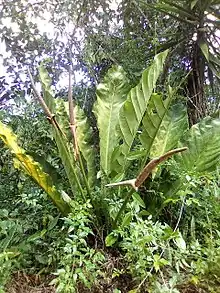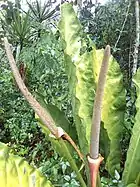Anthurium schlechtendalii
Anthurium schlechtendalii, also known as pheasants tail or cola de fasian in Spanish, (pronounced xiv ak tu ick and xiv yak tun ich in Mopan or tye-pú in ketchi Maya[1]) is a broad-leafed plant used for multiple medicinal purposes, including muscle and joint sprains, back pain, arthritis and rheumatism.
| Anthurium schlechtendalii | |
|---|---|
 | |
| Scientific classification | |
| Kingdom: | Plantae |
| Clade: | Tracheophytes |
| Clade: | Angiosperms |
| Clade: | Monocots |
| Order: | Alismatales |
| Family: | Araceae |
| Genus: | Anthurium |
| Species: | A. schlechtendalii |
| Binomial name | |
| Anthurium schlechtendalii Kunth | |
Description
Anthurium schlechtendalii is found from Mexico to Costa Rica.[2] It is a large herbaceous plant with dark green leaves, it arises from a bunch of white cord-like roots and its flower is a dark purple bract(spathe). It has fruits and when ripe they have a similar appearance to small red berries. They tend to live in wet forests, rocky hillsides or outcrops on trees.[3]

Anthurium schlechtenalii has a long, slender and brown spadix (which has pencil-like structure) that arises from the base which is about 70 cm long. It has brown bumps on the spadix which are considered its fruits which develop a lot of tiny flowers. The genus Anthurium has about 500 species, some are used as medicinal species meanwhile others are used as ornaments. The name Anthurium comes from classical Greek which translates to 'tail flower.' This species originated from Peru, Mexico, Bolivia, and Brazil.[4]
Treatment methods
For most treatments, three leaves of the plant are plucked, boiled in 2 gallons of water for 10 minutes, and used in a warm bath.
Local healers say that the cola de faisan can be used on swollen tonsils; for this the treatment the leaves are mashed with oil, heated, and placed on the neck two times a day. For cramps, muscle spasms or paralysis, the affected area is covered with a blanket and placed over the steam of the boiling decoction. To reduce swelling and inflammation, such as swollen breasts, back pain or joint pain, the leaves are mashed and applied to the affected area. The poultice "will stick to the affected part and can be worn all day" [B3507; Arvigo and Balick, 1998).
For back pain or muscle spams, the center vein of the leaf is mashed and applied to the affected area, and a hot water bottle is placed over it for one hour. For urinary infection, roots of A. schlechtendalii are retrieved and boiled in 3 cups of water for 10 minutes; then sips of the liquid are taken for 24 hours until the condition has improved.
The species is also used as a chilillo (when a dog is out of control): A handful of the roots is boiled in one quart of water for 10 minutes. One-half pint of the liquid is then force-fed the dog three times a day until symptoms abate.
References
- Balick, Michael; Arvigo, Rosita (2015). Messages from the Gods: A Guide to the Useful Plants of Belize (1st ed.). United States of America: Oxford University Press. ISBN 978-0-19-996576-2. Retrieved 2 March 2017.
- Brown, Deni (2000). AROIDS: Plants of the Arum Family (2nd ed.). Portland, Oregon 97204, U.S.A: Timber Press, Inc. ISBN 0-88192-485-7. Retrieved 2 March 2017.CS1 maint: location (link)
- Arvigo, Rosita; Balick, Michael (April 1998). Rainforest Remedies: One Hundred Healing Herbs of Belize (2nd Revised and Expanded ed.). United States of America: Lotus Press. ISBN 978-0-9149-5513-9. Retrieved 2 March 2017.
- Conrad, Jim. "Anthurium Among The Rocks". Naturalist Newsletter. Retrieved 23 February 2017.